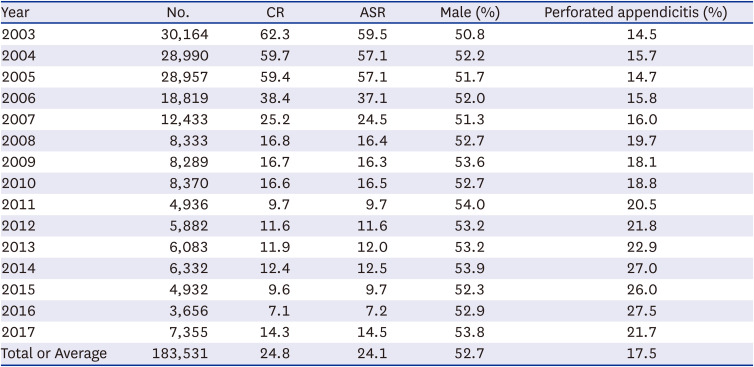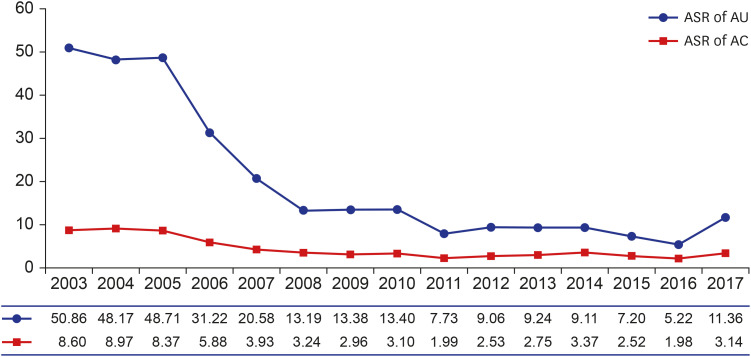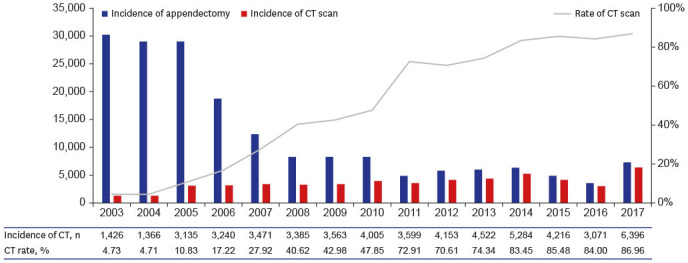1. Nishi M, Ishihara S, Nakajima T, Ohta K, Ohyama S, Ohta H. Chronological changes of characteristics of early gastric cancer and therapy: experience in the Cancer Institute Hospital of Tokyo, 1950-1994. J Cancer Res Clin Oncol. 1995; 121(9-10):535–541. PMID:
7559733.

2. Kim HH, Ahn SH. The current status and future perspectives of laparoscopic surgery for gastric cancer. J Korean Surg Soc. 2011; 81(3):151–162. PMID:
22066116.

3. Kim YI, Kim YW, Choi IJ, Kim CG, Lee JY, Cho SJ, et al. Long-term survival after endoscopic resection versus surgery in early gastric cancers. Endoscopy. 2015; 47(4):293–301. PMID:
25625697.

4. World Health Organization. Republic of Korea Health System Review. Manila, Philippines: WHO Regional Office for the Western Pacific;2015.
5. Colson M, Skinner KA, Dunnington G. High negative appendectomy rates are no longer acceptable. Am J Surg. 1997; 174(6):723–726. PMID:
9409605.

6. Doria AS, Moineddin R, Kellenberger CJ, Epelman M, Beyene J, Schuh S, et al. US or CT for diagnosis of appendicitis in children and adults? A meta-analysis. Radiology. 2006; 241(1):83–94. PMID:
16928974.

7. Tseng J, Cohen T, Melo N, Alban RF. Imaging utilization affects negative appendectomy rates in appendicitis: an ACS-NSQIP study. Am J Surg. 2019; 217(6):1094–1098. PMID:
30635205.

9. Raman SS, Osuagwu FC, Kadell B, Cryer H, Sayre J, Lu DS. Effect of CT on false positive diagnosis of appendicitis and perforation. N Engl J Med. 2008; 358(9):972–973. PMID:
18305278.

10. Braveman P, Schaaf VM, Egerter S, Bennett T, Schecter W. Insurance-related differences in the risk of ruptured appendix. N Engl J Med. 1994; 331(7):444–449. PMID:
7880234.

11. Bagger JP, Zindrou D, Taylor KM. Postoperative infection with meticillin-resistant Staphylococcus aureus and socioeconomic background. Lancet. 2004; 363(9410):706–708. PMID:
15001331.

12. Na BJ, Hong JY, Kim KY, Lee MS, Nam HS, Im JS, et al. The relation between type of insurance and acute appendicitis rupture rate. J Prev Med Public Health. 2004; 37(3):267–273. PMID:
25175473.
13. Putnam LR, Tsao K, Nguyen HT, Kellagher CM, Lally KP, Austin MT. The impact of socioeconomic status on appendiceal perforation in pediatric appendicitis. J Pediatr. 2016; 170:156–160.e1. PMID:
26922766.
14. Sutton TL, Pracht EE, Ciesla DJ. Acute appendicitis: variation in outcomes by insurance status. J Surg Res. 2016; 201(1):118–125. PMID:
26850192.

15. Drake FT, Mottey NE, Farrokhi ET, Florence MG, Johnson MG, Mock C, et al. Time to appendectomy and risk of perforation in acute appendicitis. JAMA Surg. 2014; 149(8):837–844. PMID:
24990687.

16. Sauvain MO, Slankamenac K, Muller MK, Wildi S, Metzger U, Schmid W, et al. Delaying surgery to perform CT scans for suspected appendicitis decreases the rate of negative appendectomies without increasing the rate of perforation nor postoperative complications. Langenbecks Arch Surg. 2016; 401(5):643–649. PMID:
27146319.

17. Kim JH, Kim HY, Park SK, Lee JS, Heo DS, Park SW, et al. Single-incision laparoscopic appendectomy versus conventional laparoscopic appendectomy: experiences from 1208 cases of single-incision laparoscopic appendectomy. Ann Surg. 2015; 262(6):1054–1058. PMID:
26559780.
18. Talha A, El-Haddad H, Ghazal AE, Shehata G. Laparoscopic versus open appendectomy for perforated appendicitis in adults: randomized clinical trial. Surg Endosc. 2020; 34(2):907–914. PMID:
31139982.

19. Kim WJ, Mun JY, Kim HJ, Yoon SH, Han SR, Bae JH, et al. Surgical rectus sheath block combined with multimodal pain management reduces postoperative pain and analgesic requirement after single-incision laparoscopic appendectomy: a retrospective study. Int J Colorectal Dis. 2021; 36(1):75–82. PMID:
32875376.

20. Seo JW, Kim MJ, Yoon SH, Paik KY, Park SM, Kang WK, et al. The effects of preoperative pain education on the decision to discharge patients following single-incision laparoscopic appendectomy. Ann Coloproctol. 2020; 36(6):398–402. PMID:
32054252.

21. Nechay T, Sazhin A, Titkova S, Tyagunov A, Anurov M, Melnikov-Makarchuk K, et al. Evaluation of enhanced recovery after surgery program components implemented in laparoscopic appendectomy: prospective randomized clinical study. Sci Rep. 2020; 10(1):10749. PMID:
32612104.

22. Yi GH, Lee HJ, Lee S, Yoon JH, Hong SK. Impact of an acute care surgery model on the management of acute appendicitis in South Korea: a retrospective cohort study. Emerg Med Int. 2021; 2021:5522523. PMID:
33833876.





